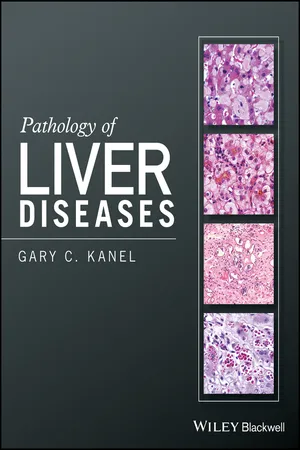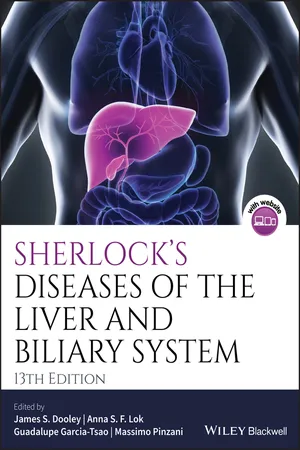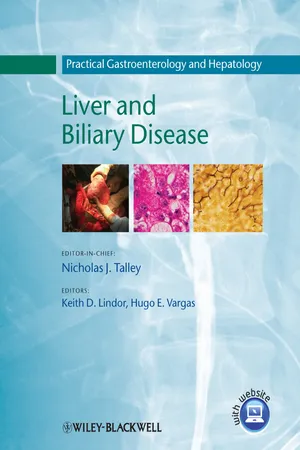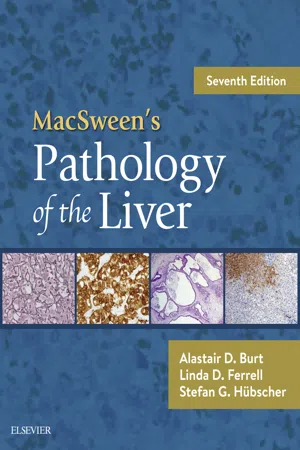Biological Sciences
Hepatitis Viruses
Hepatitis viruses are a group of viruses that cause inflammation of the liver, known as hepatitis. There are several types of hepatitis viruses, including hepatitis A, B, C, D, and E. Each type is transmitted differently and can lead to acute or chronic liver disease, with symptoms ranging from mild illness to severe liver damage.
Written by Perlego with AI-assistance
Related key terms
12 Key excerpts on "Hepatitis Viruses"
- eBook - ePub
Studies on Hepatitis Viruses
Life Cycle, Structure, Functions, and Inhibition
- Satya Prakash Gupta(Author)
- 2018(Publication Date)
- Academic Press(Publisher)
Chapter 1Viral Hepatitis
Historical Perspective, Etiology, Epidemiology, and Pathophysiology
Abstract
The chapter discusses the types of Hepatitis Viruses that are mainly hepatitis A virus (HAV), hepatitis B virus (HBV), hepatitis C virus (HCV), hepatitis D virus (HDV), and hepatitis E virus (HEV) and presents their etiology, epidemiology, and pathophysiology, which refer to manner of causation of a disease or condition, study of cause of a disease, and physiology of abnormal states, respectively.Keywords
Epidemiology; Etiology; Hepatitis Viruses; Pathophysiology1. Introduction
Hepatitis refers to inflammation of the liver, which is primarily caused by viruses called Hepatitis Viruses. So far, there are five known Hepatitis Viruses, called hepatitis A virus (HAV), hepatitis B virus (HBV), hepatitis C virus (HCV), hepatitis D virus (HDV), and hepatitis E virus (HEV). In United States, the first three viruses, i.e., HAV, HBV, and HCV, are more prevalent. The symptoms of their infection are usually nausea, abdominal pain, fatigue, malaise, and jaundice (Wasley et al., 2008 ). Hepatitis may be temporary (acute) or long term (chronic), depending on whether it lasts for less or more than 6 months. Acute hepatitis can sometimes resolve on its own or progress to chronic hepatitis, which over time may progress to liver failure or liver cancer. HBV and HCV may lead to chronic infection, causing cirrhosis and hepatocellular carcinoma (HCC) (Wasley et al., 2008 ). The most common effect of HAV and HEV is the sudden onset of fever and systemic symptoms, followed a few days later by jaundice. HDV may also cause chronic infection, but it affects only in presence of HBV infection; hence an individual protected against HBV is hardly affected by HDV. Three viruses—HBV, HCV, and HDV—are transmitted in the body parenterally, while the remaining two—HAV and HEV—can be transmitted enterally.Compared to human immunodeficiency virus (HIV), Hepatitis Viruses are less publicized. They are recognized as silent killers. According to World Health Organization (WHO), about 400 million people worldwide are suffering with chronic hepatitis viral infection. More than 1 million people die of liver cirrhosis caused by Hepatitis Viruses, and HCC is the third leading cause of cancer deaths, claiming more than 500,000 lives each year. In spite of the prevalence of hepatitis, no symptoms of chronic viral hepatitis are recognized until patients develop complications of cirrhosis or liver cancer, and once symptoms occur, currently available remedies are often ineffective and/or expensive. Given the large burden of viral hepatitis, governments around the world have made various efforts to mitigate its impact. WHO has set a goal to eliminate viral hepatitis as a major public health threat by 2030. - eBook - ePub
Infections in Systemic Autoimmune Diseases
Risk Factors and Management
- (Author)
- 2020(Publication Date)
- Elsevier(Publisher)
Viral hepatitis is a major global public health problem affecting hundreds of millions of people and is associated with significant morbidity and mortality. There are five major hepatotropic viruses: hepatitis A virus (HAV), hepatitis B virus (HBV), hepatitis C virus (HCV), hepatitis D (delta) virus (HDV), and hepatitis E virus (HEV).These are biologically unrelated and have distinct differences in their epidemiology, routes of transmission, presentations, diagnostics, treatments, and prognosis. Influences of autoimmune conditions on these infections, and especially the effects of treatment for rheumatological and autoimmune diseases, have recently been areas of significant interest (see Table 4.1 ).In this chapter, we briefly review the relevant background to each virus, but especially focus on rheumatological presentations of these infections, the influence and associations of rheumatological diseases and treatments on each, and what the rheumatologist needs to be aware of and consider in an individual known to be infected by, or be at risk of, a hepatitis virus.1. Hepatitis A
1.1. Virology and pathogenesis
HAV is single-strain positive-sense RNA virus, classified in a unique serotype divided into six genotypes. Genotypes I to III infect humans, while genotypes IV to VI are endemic among nonhuman primates. HAV is present in the host in two forms: naked virions (shed in the feces), and quasi-enveloped virions (that circulate in the blood)—both forms are infectious. HAV does not have a significant direct cytopathic effect, and most liver damage is thought to be due to the host immune response. Cellular immunity appears responsible for viral clearance after primary infection, while humoral immunity is vital for the prevention of infection. - eBook - ePub
- Gary C. Kanel(Author)
- 2017(Publication Date)
- Wiley-Blackwell(Publisher)
2 Viral HepatitisViral hepatitis is an acute and chronic necroinflammatory process of the liver that can be subdivided into infection by either one of the hepatotropic viruses (viral infection mostly localized to the liver) or by a system virus affecting the liver but other organ systems as well. This chapter discusses the epidemiology, virology, and clinical and biological behavior of these viruses with the characteristic pathologic changes seen in liver biopsy material.Viral Hepatitis Secondary to Infection by the Hepatotropic Viruses
General Characteristics and Clinical Presentations
Table 2.1 lists the six hepatotropic viruses – hepatitis A, B, δ, C, E, and G virus (HAV, HBV, δ [delta], HCV, HEV, and GVH-C) – and their epidemiology and clinical course, with the most pertinent serologic markers summarized in Table 2.2 . Although each of the viruses has various individual characteristic, the general basic features of acute and chronic hepatitis are discussed below.Hepatotropic viruses with epidemiologic and clinical parametersTable 2.1Hepatitis A virus (HAV)Hepatitis B virus (HBV)Delta (δ) virus (HDV)Hepatitis C virus (HCV)Hepatitis E virus (HEV)Hepatitis G virus (HGV)Virus type and genome ss RNA Picornavirus 27–28 nm 3 genotypes ds DNA Hepadnavirus 42 nm Dane particle 8 genotypes ss Defective RNA enveloped by HBV surface antigen 36 nm 4 genotypes ss RNA Flavivirus 30–38 nm 6 genotypes ss RNA Hepevirus 27–34 nm 5 genotypes ss RNA Flavivirus 50–100 nm 6 genotypes Incubation period 15–45 days (mean 25) 30–180 days (mean 75) 30–180 days (mean 35) 15–160 days (mean 50) 14–60 days (mean 40) 20–140 Transmission Fecal–oral Percutaneous, sexual, perinatal Percutaneous, sexual, perinatal Percutaneous, sexual, perinatal Fecal–oral Parenteral, sexual, perinatal - eBook - ePub
- Alex P. Mowat(Author)
- 2013(Publication Date)
- Butterworth-Heinemann(Publisher)
Chapter 6Viral infections of the liver
Publisher Summary
This chapter discusses the clinical features, prevention, and treatment of various viral infections of the liver, such as acute viral hepatitis type A, viral hepatitis type B, viral hepatitis type C, delta hepatitis, herpes simplex hepatitis, and mosquito borne viral hepatitis. It also explains the viruses that have a high degree of hepatic trophism. Acute viral hepatitis type A is an acute inflammation of the liver with varying degrees of hepatocellular necrosis caused by the enterically transmitted hepatitis A virus (HAV), a member of the picornavirus family. The hepatitis is usually benign but severity may increase with age. There are no long-term sequelae but the disease may be relapsing. Viral hepatitis type B is caused by the hepatitis B virus (HBV), a double-stranded DNA virus of the hepadnavirus family which has unique biological properties. Unlike hepatitis A virus the host immunological response may be ineffective leading to chronic infection. Transmission of HBV occurs by the parenteral route; however, as minute quantities of blood are infective it may be blood-borne via unapparent fomites. In saliva and semen viral concentrations are 100–1000 times less than in blood but both have been shown to be infective in experimental studies. Hepatitis C virus (HCV) has been shown to cause the majority of cases of post-transfusion non-A non-B hepatitis and much sporadic, community acquired non-A non-B hepatitis in many parts of the world.Hepatitis
The term hepatitis indicates an inflammation of the liver, usually associated with hepatocyte degeneration or necrosis. The cause may be infective, toxic, genetically determined, physical, ischaemic or cryptogenic. The course may be acute or chronic. Although it is usual to characterize the hepatitis by the aetiological factor, the wide range of clinical manifestations seen in any of the above types is determined by the severity of the alterations in hepatocyte function. At one end of the scale is an asymptomatic hepatitis in which hepatocellular necrosis is minimal and revealed only by elevation of serum enzymes such as aspartate aminotransferase, at the other end is fulminant hepatitis associated with massive hepatocellular necrosis, hepatic encephalopathy and spontaneous haemorrhage. Hepatitis in infancy is considered in Chapter 4 - eBook - ePub
- Tadataka Yamada, Tadataka Yamada(Authors)
- 2011(Publication Date)
- Wiley-Blackwell(Publisher)
80 Acute viral hepatitis Marc G. Ghany, T. Jake LiangEpidemiology Virology Pathogenesis Clinical manifestations Diagnosis and differential diagnosis Course and complications Prevention and immunoprophylaxis Treatment Other virusesFive viral agents have been associated with acute hepatitis. These viruses were denominated A, B, C, D, and E in order of their discovery. They are a genetically diverse group of viruses linked by their tropism for the liver, their primary site of replication. They all cause an acute hepatitis, which can range in clinical severity from an asymptomatic illness to fulminant hepatitis. Hepatitis B, C, and D viruses have the propensity to progress to chronic hepatitis. These hepatotrophic viruses account for 90–95% of all cases of acute viral hepatitis in the United States [1]. Data from the Centers for Disease Control and Prevention (CDC) Sentinel Counties Study of acute viral hepatitis indicated that hepatitis A virus (HAV) was the cause of almost half the reported cases, hepatitis B virus (HBV) caused a third, hepatitis C virus (HCV) caused 15%, and the remaining cases were caused by non-A, non-C viruses [2]. In the United States, acute viral hepatitis has a low case fatality rate, 1%–2%, but is associated with substantial morbidity. Death from end-stage liver disease, a long-term consequence of acute viral hepatitis, ranks in the top 10 of all causes of mortality in the United States.Other viruses from the families Arenaviridae (e.g., Lassa fever virus), Bunyaviridae (e.g., Rift Valley fever and Hanta viruses), Flaviviridae (e.g., yellow fever and dengue viruses), Filoviridae (e.g., Marburg and Ebola viruses), and Herpes-viridae may cause hepatitis as part of a systemic illness but are not considered primary hepatotrophic viruses.Epidemiology OverviewThe hepatotrophic viruses are found worldwide, and there are distinct geographic regions where each virus is highly endemic. The global distribution of each virus is closely linked to its mode of transmission. Enterically transmitted viruses, HAV and hepatitis E virus (HEV), are more common in regions of the world that lack proper sanitation and have limited access to fresh water. In contrast, the parenterally transmitted viruses, HBV, HCV, and hepatitis D virus (HDV), predominate in areas of the world where social or customary practices facilitate their transmission, explaining the high rate of HCV infection in injection drug users in the United States and HDV in the South American Indians of the Amazon basin. Despite the institution of public health measures to educate the general public on transmission risks, the number of cases of acute viral hepatitis has not declined substantially in recent years. This may be partly because risk factors for acute viral hepatitis have not been identified in 30%–40% of cases [1]. If elimination of infection is the ultimate goal, further studies on the various modes of transmission are necessary. - Barbara Detrick, John L. Schmitz, Robert G. Hamilton, Barbara Detrick, Robert G. Hamilton, John L. Schmitz(Authors)
- 2016(Publication Date)
- ASM Press(Publisher)
36 ). The positive-stranded RNA virus was named hepatitis C virus. HCV is an important cause of liver disease, cirrhosis, and HCC worldwide. Humans are known to be the only natural reservoir of the virus.HCV belongs to the genus Hepacivirus and is the only member of this group, within the family Flaviviridae . Other genera within the Flaviviridae are Pestivirus and Flavivirus . It is an enveloped, positive-sense RNA virus with a genome of 9.6 kb in length that encodes a single long ORF of ~3,000 amino acids, flanked by short UTRs at the 5′ and 3′ ends. The viral genome is translated directly into a polyprotein that is cleaved both post- and cotranslationally by viral and cellular proteases to generate 10 gene products. HCV particles are 40 to 80 nm in diameter and are pleomorphic, without apparent symmetry.The amino-terminal part of the polyprotein encodes the structural proteins, i.e., the capsid-forming “core” protein and the envelope glycoproteins E1 and E2. The carboxy-terminal two-thirds of the polyprotein encodes the nonstructural proteins, i.e., p7 (an ion channel), NS2 (a transmembrane protein), NS3 (the protease and RNA helicase), NS4A and NS4B (cofactors), NS5A (a phosphoprotein), and NS5B (the viral RNA-dependent RNA polymerase).The lack of suitable culture systems has hampered research into the interactions between host and virus. Therefore, essential details required for more advanced understanding of virus entry, replication, interaction with the immune system, and virus assembly are still unknown. A striking feature of infectious HCV particles is their association with lipoproteins. These are particles, produced in the liver, that serve to transport lipids between liver and tissues. The apolipoproteins are a group of molecules, present on the surface of lipoproteins, that act as chaperones directing the trafficking of lipids throughout the body. Serum-derived HCV particles have been found to associate with apolipoproteins A1 (apoA1), apoB-4B, apoB100, apoC-1, and apoE. This interaction suggests that HCV forms hybrid lipoviral particles, which facilitate virus entry into hepatocytes and possibly protect the virus from antibody neutralization (37- Richard L. Guerrant, David H. Walker, Peter F. Weller(Authors)
- 2011(Publication Date)
- Saunders(Publisher)
CHAPTER 66 Hepatitis B and Deltavirus Infections Ding-Shinn Chen, Pei-Jer Chen Access the complete reference list online at http://www.expertconsult.com Hepatitis B Introduction Hepatitis B virus (HBV) infection is one of the most common and important human viral infections. The infection can cause acute and chronic liver disease, ranging from fulminant hepatitis to cirrhosis and eventually hepatocellular carcinoma (HCC). 1, 2 Worldwide, as many as 360 million people are chronically infected with HBV, and around 1 million deaths annually are attributed to this infection. Hence, control of HBV infection is extremely important. Strategies to combat HBV infection comprise interrupting transmission, treating chronically infected patients, as well as providing susceptible individuals with immunoprophylaxis. 3 The Agent HBV is a double-stranded DNA virus of 3200 base pairs and is the prototype virus of the Hepadnaviridae family. The intact virions are 42 nm in diameter (Dane particle). In the serum, intact virions are found in association with more abundant 20-nm, DNA-free, spherical and tubular particles containing the hepatitis B surface antigen (HBsAg) and host-derived lipids. 4 The viral genome encodes four overlapping open reading frames (ORFs): S, C, P, and X. 4 The S ORF encodes the viral surface envelope proteins, HBsAg, which can be divided into the pre-S1, pre-S2, and S regions. The C (core) gene has the precore and core regions. The C ORF encodes either the viral nucleocapsid hepatitis B core antigen (HBcAg) or hepatitis B e antigen (HBeAg), depending on whether translation is initiated from the core or precore region, respectively. The core protein can self-assemble into a capsid-like structure. The precore ORF codes for a signal peptide that directs the translation product to the endoplasmic reticulum, where the protein is further processed to the secreted HBeAg- eBook - ePub
- Dongyou Liu, Dongyou Liu(Authors)
- 2018(Publication Date)
- CRC Press(Publisher)
hepatitis A virus (HAV)—using the first letter of the English language—in keeping with the provisional nomenclature, even though the agent for parenteral hepatitis (the “hepatitis B virus”) had been discovered before it. Since then, additional distinct hepatotropic viruses with predominant parenteral (hepatitis C virus and hepatitis D virus) or oral (hepatitis E virus) spread have been discovered.6.2Classification, Morphology, and Structure 6.2.1TaxonomyIn 2014, the International Committee on Taxonomy of Viruses renamed HAV as Hepatovirus A . This species is the sole member of the genus Hepatovirus , a member of the family Picornaviridae , which contains several small RNA viruses with icosahedral symmetry.6.2.2Virus Structure, Genome, and PolyproteinHAV virions are small particles (∼ 27 nm) with icosahedral symmetry and a single-stranded, positive-sense RNA genome surrounded by a protein capsid. The virus is stable at low pH and at 60°C for up to 1 hour, but is destroyed by autoclaving, boiling for about 5 minutes, or exposure to ultraviolet radiation, formalin, beta-propiolactone, iodine, chlorine, or chlorine-containing compounds.HAV virions were traditionally considered to be nonenveloped. However, recent evidence indicates the existence of an alternative form that has an envelope derived from the host cell membrane.3 , 4 These enveloped virions can evade neutralization by HAV-specific antibodies, and hence can circulate freely in the blood to reach the liver and infect fresh hepatocytes, thus amplifying the infection. By contrast, nonenveloped virions are secreted into the bile and excreted in feces, and go on to infect new hosts.The viral capsid is composed of 60 units each of three proteins, namely, VP1, VP2, and VP3 (known also as 1D, 1B, and 1C, respectively), and encloses a linear, single-stranded, positive-sense RNA genome of approximately 7500 nucleotides in length. The viral RNA includes a 5′ -untranslated region (UTR), a single open reading frame, and a 3′ -UTR with a short polyadenosine tail. The 5′ -UTR contains an internal ribosomal entry site, which is important for initiation of cap-independent translation of the viral RNA. The open reading frame codes for a large polypeptide, which undergoes cotranslational and posttranslational cleavage into several structural (VP1, VP2, and VP3) and nonstructural (2B, 2C, 3A, 3B, 3Cpro , and 3Dpol ) proteins, and proteins with unclear functions (VP4 and 2A).5 This cleavage is mediated by a viral cysteine protease (3Cpro - James S. Dooley, Anna S. Lok, Guadalupe Garcia-Tsao, Massimo Pinzani, James S. Dooley, Anna S. F. Lok, Guadalupe Garcia-Tsao, Massimo Pinzani(Authors)
- 2018(Publication Date)
- Wiley-Blackwell(Publisher)
Chapter 5 .The patient should be monitored until symptoms are resolved and liver tests return to normal. Special attention should be paid to recurrence of jaundice. Exercise can be undertaken within the limits of fatigue. Alcohol must be denied for 3–6 months. Diet can be unrestricted.Hepatitis A virus
Hepatitis A accounts for 20–25% of clinical hepatitis in the developed world. It is largely asymptomatic in children under the age of 15 years. The causative agent of this infection is a small, spherical, positive‐sense RNA virus, measuring 27 nm in diameter [16] . It belongs to the Picornaviridae family of viruses, under the genus Hepatovirus.The capsid (outer coat) consists of 60 capsomeres, each made up of the same four structural viral proteins, VP1, VP2, VP3, and VP4 [17] . The capsid encloses the RNA genome of the virus encoding its genetic information. The genome contains a single open reading frame (ORF) that is translated into a polyprotein. This is cleaved by the viral protease enzyme to produce the four VP peptides and a number of non‐structural peptides, which are important for the replication of the virus.Sequencing studies have revealed that in the human population there are three circulating genotypes of the virus and each genotype is subdivided into two subgenotypes [18] . Only a single serotype has been identified.The virus enters the body through the gastrointestinal tract, and in the marmoset there is suggestive evidence that it replicates here [19] . This is followed by a brief period of viraemia when the virus infects and replicates within the hepatocytes, which is the main site of virion production (Fig. 20.4 ). Cell uptake may involve attachment of the virus to the asialoglycoprotein receptor via IgA–virus complexes or the HAVCR1/TIM (T‐cell immunoglobulin mucin) receptor with its IgA1 lambda ligand, which has a synergistic effect on virus–receptor interaction [20]- eBook - ePub
Practical Gastroenterology and Hepatology
Liver and Biliary Disease
- Keith D. Lindor, Hugo E. Vargas, Keith D. Lindor, Hugo E. Vargas(Authors)
- 2011(Publication Date)
- Wiley-Blackwell(Publisher)
Liver involvement in EBV infection is common, but generally manifests as transient and self-limited transaminitis (80–90%) or hyperbilirubinemia ( < 10%) within the course of mononucleosis. Histologic findings include minimal swelling and vacuolization of hepatocytes with lymphocytic and monocytic portal infiltration. Severe cholestasis and liver failure are uncommon in immuno-competent individuals, but have been described in patients with recent organ transplantation or with immunodeficiency from AIDS, X-linked lymphoproliferative disease (Duncan disease), or chemotherapy. Some authors have described “ chronic ” hepatitis in the setting of chronic EBV infection [24,25].No reliable diagnostic criteria for EBV hepatitis are available, but at present diagnosis should be based on the combination of the following parameters: elevated ami-notransferases, EBV serology consistent with active infection, typical histology, and demonstration of viral DNA in liver tissue. Antiviral therapy with acyclovir or ganciclovir is warranted in severe cases of EBV hepatitis, especially in immunosuppressed patients [25].Take-home points- Hepatitis A (HAV) and hepatitis E (HEV) are enterically-transmitted RNA viruses that share common clinical features.
- Epidemiology of hepatitis A is changing as a consequence of worldwide vaccination efforts.
- Recent outbreaks of HEV in industrialized nations have pointed to the zoonotic nature of this infection.
- Clinical presentation of HAV and HEV are commonly indistinguishable from other causes of acute hepatitis and a broad differential diagnosis must be considered.
- Diagnosis of acute hepatitis A relies on detection of serum anti-HAV IgM, while that of hepatitis E requires heightened clinical suspicion and serologic or molecular confirmation.
- Clinical course of hepatitis A is generally self-limited, with occasional atypical presentations, including cholestatic hepatitis, relapsing hepatitis, and acute liver failure.
- Cases of chronic hepatitis E and cirrhosis in transplant recipients have been recently described.
- Mortality of hepatitis E is greater than that of hepatitis A, especially in pregnant patients who have a case fatality rate of 25–30%.
- Effective immunoprophylaxis for hepatitis A is widely available, while a safe and effective recombinant HEV vaccine has recently completed phase III clinical trials.
- Other viruses such as herpesviruses, adenoviruses, enteroviruses, and parvovirus B-19, among others, can cause acute hepatitis and have significant consequences in immunocompromised individuals.
References1 Di Giammarino L, Dienstag JL. Hepatitis A. In: Rodés J, Benhamou JP, Blei A, Reichen J, Rizzetto M (eds) Textbook of Hepatology: From Basic Science to Clinical Practice - eBook - ePub
Infectious Causes of Cancer
A Guide for Nurses and Healthcare Professionals
- Kenneth Campbell(Author)
- 2011(Publication Date)
- Wiley(Publisher)
14 . It is now estimated that the risk per 100 000 units of transfusion transmitted HCV is no higher than 0.024 and that of HBV no greater than 0.176.Hepatitis B15IARC statusHepatitis B (HBV) belongs to the hepadnavirus family of viruses, which are hepatotropic (selectively infect liver cells) and highly species-specific. HBV is the only hepadnavirus which infects humans although closely related species infect'apes, woodchucks (woodchuck hepatitis virus [WHV]), squirrels (ground squirrel hepatitis virus [GSHV]), herons (heron hepatitis B virus), ducks (duck hepatitis B virus), geese (goose hepatitis B virus), and cranes (crane hepatitis B virus)'16 . Woodchuck and duck Hepatitis Viruses 'provide model systems for the study of viral replication, pathogenesis and evaluation of antiviral drugs against HBV' 15 . Hepadnaviruses have a genome which is circular and partially double-stranded; this is transcribed to a single-stranded RNA from which reverse transcriptase generates fully double-stranded functional DNA. HBV mature virions exit the cell not by causing lysis but via the Golgi apparatus and endoplasmic reticulum; in other words by utilizing normal secretory processes; this is a significant factor in minimizing the immune reaction, although it is clearly not the only factor as HCV is also minimally cytopathic, yet provokes a strong innate immune reaction.The HBV genome contains no known oncogenes; the HBx gene product is thought to play a key role in causation of HCC but its mode of action is unclear15,16 . Transgenic mice expressing the HBx gene develop HCC17 . Although integration of the HBV genome is a common precursor to HCC, evidence suggests that 'insertional mutagenesis' - in which integration activates an oncogene or inactivates a tumour suppressor - occurs rarely18 .Chronic active infection leading to cirrhosis is a key risk factor for development of liver cancer. The outcome of HBV infection depends on the host’s immune system; if the host immune response is adequate, the infection is rapidly and completely cleared, if the response is very weak, chronic inactive infection is established, with minimal liver damage. Chronic active hepatitis, potentially leading to cirrhosis, occurs when the host mounts an immune response which is inadequate to clear the infection, but which damages virus-infected liver cells19,20 . As described in earlier chapters, an association between chronic inflammation and cancer is very well established. Although the majority of patients with HCC have pre-existing cirrhosis this is not a necessary factor for development of HBV-associated liver cancer, with up to 40% of the latter group developing HCC before cirrhosis21 - Available until 21 Sep |Learn more
- Alastair D. Burt, Linda D. Ferrell, Stefan G. Hübscher(Authors)
- 2017(Publication Date)
- Elsevier(Publisher)
Against direct cytotoxicity are the findings that transgenic mice expressing HDAg do not display liver damage 331, 332 ; neither do mice infected with the virus, despite the ability to maintain viral replication. 333 Furthermore, many studies have shown stable infection of cultured cell lines without evident cell injury. On the other hand, the expression of a small amount of HDAg, inducibly driven by a metallothionein promoter, led to cell death. 334 Another possible mechanism of cytotoxicity might relate to the virus utilizing host RNA polymerase II, thereby competing with host gene transcription, and viral replication is inhibited. 325 Clinically, a description of microvesicular steatosis also suggests mitochondrial injury, in epidemics of severe hepatitis D in regions of South America, although this may specifically relate to a particular subtype of the virus. 335 As in hepatitis B and C, the immune response in hepatitis D is probably important in causing hepatocellular injury, although the details of immunopathogenesis are poorly understood. It is known that disease activity in acute hepatitis D is associated temporally with increased immune response and diminished HDV replication. 325, 326 However, separating this from the immune response triggered against HBV directly is clearly difficult. Hepatitis E Hepatitis E virus (HEV), formerly classified as one of the forms of ‘non-A, non-B’ Hepatitis Viruses, 336 is an nonenveloped, single-stranded RNA virus. 337 Viral particles measure approximately 27–34 nm in diameter and have spiky outlines. These can be found in faeces of infected patients and have also been demonstrated within bile ductules and hepatic sinusoidal cells of a patient with fatal cholestatic hepatitis E, 337 as well as in the hepatocytes of infected monkeys. 338 In the livers of infected primates, close contact between lymphocytes and damaged hepatocytes suggests that immunological mechanisms are involved in the pathogenesis of the disease
Index pages curate the most relevant extracts from our library of academic textbooks. They’ve been created using an in-house natural language model (NLM), each adding context and meaning to key research topics.











